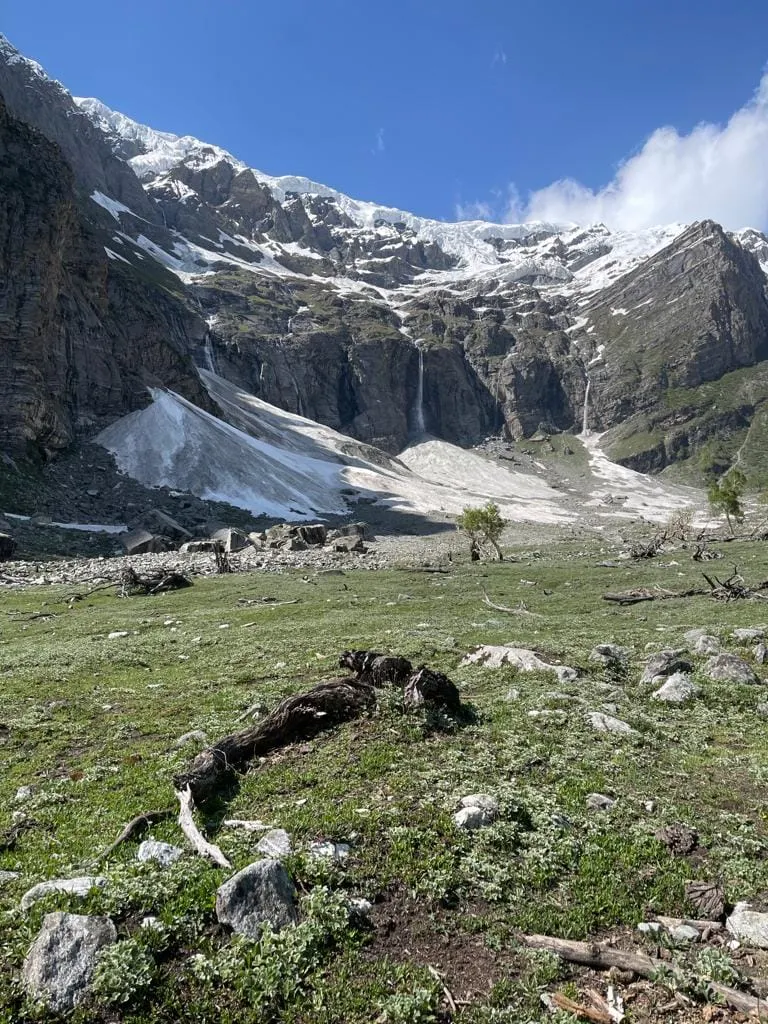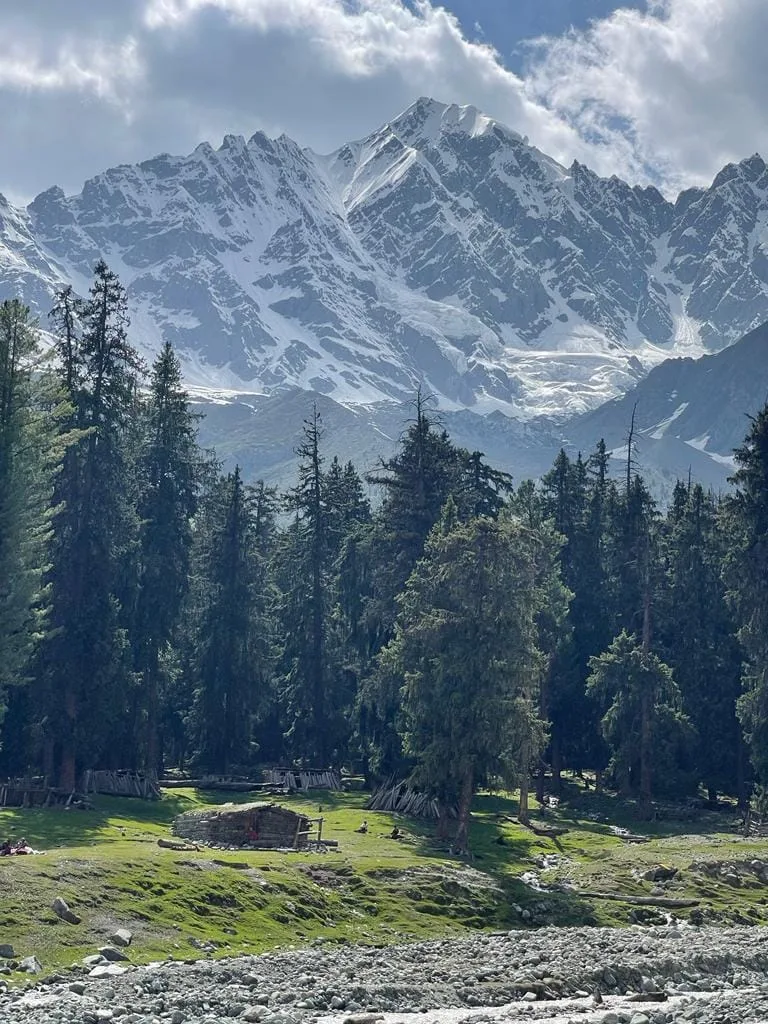Khaltaro valley and Haramosh valley home of Haramosh peak, Khun meadows and Katwal lake. these are two stunning less explored valleys located in the Gilgit-Baltistan region of Pakistan on Skardu road. These valleys offer untouched natural beauty, majestic mountain scenery, and a sense of serenity for those seeking off-the-beaten-path destinations.
Haramosh Valley:
Haramosh valley is nestled at the base of the majestic Haramosh Peak, a towering mountain that rises to 7,409 meters and one of the tallest and most rugged mountains in the Karakoram range. This valley is known for its lake, glacier, lush green meadows, and tranquil atmosphere, making it a paradise for trekkers, mountaineers, and nature lovers. The valley is home to the highest peaks of Karakoram range Haramosh I 7,409m, Haramosh II 6666m Kutwal Sar, Mani Peak, Laila Peak and Malubiting peak. The valley is rich with alpine meadows where herds of livestock graze. The famous is Majahrai Meadows, these meadows also attract local wildlife, including ibex, snow leopards, and a variety of birds. The Kutwal Lake, formed by the Kutwal Glacier, is a breathtaking sight in the valley. The turquoise lake, surrounded by towering peaks, offers a serene and picturesque spot for trekkers and campers.
Haramosh peak and Haramosh Valley trek
Wildlife and Flora
Haramosh valley is also home to a variety of flora and fauna. Dense forests of pine, juniper, and other native plants can be found along the valley, along with wildlife such as Himalayan ibex and marmots.
Haramosh Peak:
Dominating the Haramosh valley is the mighty Haramosh Peak, a group of Rakaposhi-Haramosh Mountains sub range of the Karakoram range. Its imposing presence attracts experienced climbers from around the world. The trek to Haramosh Peak is challenging, offering an adventurous route through glaciers, moraines, and rocky terrain. Haramosh Peak is situated 65 kilometers to the east of Gilgit, within the south-central part of the Rakaposhi-Haramosh Mountains.
Kutwal Lake
The trek to Kutwal Lake in the Haramosh valley is an exhilarating journey that takes you through some of the most scenic landscapes in Gilgit-Baltistan. the trek offers stunning views of towering peaks, Mani glacier, dense forests, and pristine meadows. As you approach the lake, you’ll begin to see towering peaks like Haramosh 7,397 meters, Mani peak 6685 m and Laila Peak 6,096 meters.
Upon reaching Kutwal Lake, you'll be rewarded with its breathtaking beauty, surrounded by snow-capped peaks. The lake’s crystal-clear waters reflect the surrounding mountains, creating a magical setting. You can set up your camp near the lake, where you'll be surrounded by majestic peaks. The area is ideal for stargazing, photography, and simply enjoying the serenity of the mountains.
Distance Haramosh valley trek
Trek starts from Sassi, situated on the Gilgit-Skardu route. Sassi is situated 65 kilometers to the east of Gilgit.
Hire jeep from Sassi or Gilgit city to Iskere.
Iskere Start of the trek, gradual ascent. Iskere to Kutwal Lake (Cross Kutwal Glacier, scenic beauty).
Final reach Kutwal Lake, You can set up your camp near the lake to see mighty Haramosh Peak
A further 1 trek goes to Kutwal Lake to Haramosh La base camp (Tough ascent).
The Haramosh valley trek offers a unique blend of adventure, natural beauty, and cultural experience, making it one of the most rewarding yet lesser-known treks in Pakistan.
there is one more longest Haramosh valley trek via Chogo Lungma Glacier. which is indeed one of the longest and most challenging treks in the region.
Haramosh valley trek start from Arando, The trek begins with a walk along the Chogo Lungma Shigar River from Skardu side via Laila Peak basecamp over Haramosh La to reach Haramosh valley.
Khaltaro Valley:
Khaltaro valley lies adjacent to Haramosh, offering equally captivating landscapes and hidden treasures for those willing to explore. This valley is lesser known but holds significant cultural and historical importance. This valley is known for lush green Raijut Meadows, Khaya meadows and Khun meadows, 7 hidden waterfalls, and tranquil atmosphere, making it a paradise for trekkers, mountaineers, and nature lovers. The valley is home to the highest peaks of Karakoram range Bilchhar Dobani, Juto Sar, Phuparash Group, Miar Chhish and Malubiting.
The people of Khaltaro Valley maintain their traditional way of life, with agriculture and livestock being the primary sources of livelihood. The local culture, languages, and customs have remained largely untouched by modernization, giving visitors an authentic experience of the region.
Khaltaro road:
Khaltaro road is one of the most dangerous roads to experience in Gilgit baltistan. Khaltaro valley trek is one of the most challenging, dangerous roads. Khaltaro road is considered the most challenging, dangerous road in Gilgit baltistan and Pakistan. It is almost a 15 km 4x4 track from Sassi and 65km from Gilgit . Road considered one of the most dangerous tracks in the world, especially in rain.only jeep track because the road is unpaved, rocky vertical mountain, unprotected both sides, deep ditch, small turns and suddenly the road goes up, never attempt it on bike and car ever.
Khaltaro Fort: One of the valley's key historical landmarks is the ancient Khaltaro Fort, which stands as a reminder of the region's past rulers and tribal conflicts. The fort offers a glimpse into the region’s history and architecture.
Khun Meadows:
Khun Meadows in Khaltaro Valley is surrounded by several prominent peaks that add to its majestic landscape. you can see highest peaks of Karakoram and Himalayas mountain Nanga parbat 8,126 m (2nd highest in Pakistan and 9th in the World), Haramosh-I 7,409, Malubiting groups Malubiting I 7,458, Juto Sar, Dubbani 6142m, Khaltaro peak, Phuparash peak, Bilchhar Dobani 6134 m, Phuparash peak, Miar groups Miar Chhish I 6824 m, minawar 4110 m, Charoi lat 4001m, saddle peak 6574m, Jut Sar groups Jut Sar center 6800 m and many more. These peaks, along with numerous unnamed ridges and mountains, create a mesmerizing skyline that makes Khun Meadows a perfect spot for those seeking to immerse themselves in nature and mountain scenery.
Distance Khaltaro valley trek
Trek starts from Sassi, situated on the Gilgit-Skardu route. Sassi is situated 65 kilometers to the east of Gilgit.
Hire jeep from Sassi or Gilgit city to Khaltaro valley.
Wildlife and Flora:
Khaltaro valley is also home to a variety of flora and fauna. Dense forests of pine, juniper, and other native plants can be found along the valley, along with wildlife such as Himalayan ibex and marmots.
Trekking Routes in Haramosh Valley and Khaltaro Valley:
For trekking enthusiasts, Haramosh and Khaltaro offer a range of trekking opportunities. One of the popular routes is the trek to Kutwal Lake, the Haramosh La Pass and Rakhan Gali. Treks in these valleys require preparation, as the terrain is rugged and challenging.
Haramosh La Pass
It connects Haramosh valley to Chogo Lungma Glacier 47km longest in Karakomran range to Arando valley Shigar District. Arando valley is also hidden treasures for those willing to explore
Rakhan Gali pass
It connects Khaltaro valley to Bagrot valley. Bagrot valley is also famous for its untouched natural beauty, lush green meadows and majestic mountain scenery
Local Hospitality of Haramosh Valley and Khaltaro Valley :
The local inhabitants of Haramosh and Khaltaro valleys are known for their hospitality. They often offer a warm welcome to visitors, providing food and shelter in their traditional homes. Their simple way of life and genuine warmth adds to the overall experience of visiting these hidden gems.
Both Haramosh and Khaltaro valleys are dream destinations for those seeking adventure, natural beauty, and a deeper connection with the untouched landscapes of northern Pakistan. The valley is home to Mani Glacier, Baskai glacier, Phuparash Glacier. While they are not as well-known as other areas like Hunza or Skardu, they provide an equally awe-inspiring experience for those willing to explore. Due to less information about these valleys and unpaved road conditions, it is very difficult for tourists to explore in the area.



































No comments:
Post a Comment